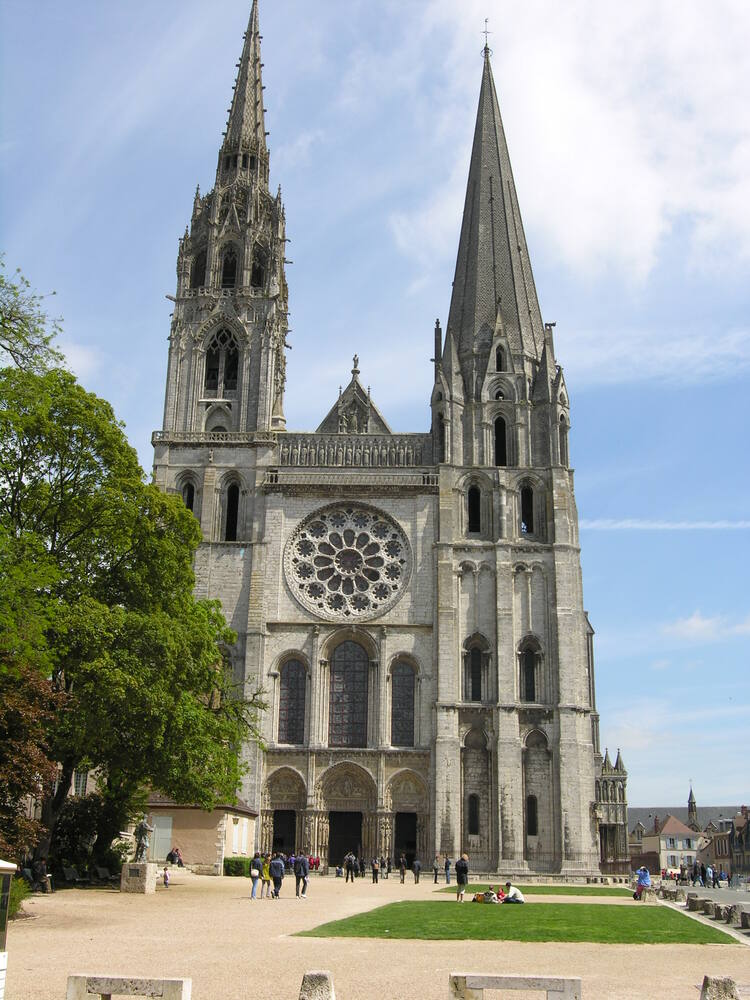 The Chartres Cathedral, also known as the Notre Dame d'Chartres, (not to be confused with the Notre Dame of Paris, France) is located in northern France in the town of Chartres. The town sits very close to Paris and has hosted a few of history's important events such as the coronation of Saint Bernard and King Henry IV. The cathedrals construction started in 1190 C.E. and was built over a preexisting cathedral which was burned down in 1194, it was completed in 1220 C.E. It gained attraction because of its immense size and the number of stained glass windows that was virtually unmatched by any other building of the time. The windows are still intact today and display different religious images like the Virgin Mary. The cathedral was constructed in many different stages and featured a few different additions that eventually led to the current state of the building.
The Chartres Cathedral, also known as the Notre Dame d'Chartres, (not to be confused with the Notre Dame of Paris, France) is located in northern France in the town of Chartres. The town sits very close to Paris and has hosted a few of history's important events such as the coronation of Saint Bernard and King Henry IV. The cathedrals construction started in 1190 C.E. and was built over a preexisting cathedral which was burned down in 1194, it was completed in 1220 C.E. It gained attraction because of its immense size and the number of stained glass windows that was virtually unmatched by any other building of the time. The windows are still intact today and display different religious images like the Virgin Mary. The cathedral was constructed in many different stages and featured a few different additions that eventually led to the current state of the building.
An interesting aspect of the layout in the Chartres Cathedral is the flooring. The flooring features a 32-meter wide painted labyrinth located in the center of the cathedral. The purpose of this labyrinth was to have the cathedral visitors walk or crawl around the path of the labyrinth to mimic the pilgrims journey to Jerusalem. These floor labyrinths were actually common in many medieval churches. These labyrinths come from Greek mythology which shows the influence of ancient civilizations on the middle ages. The Chartres Cathedral was an incredibly important building in the middle ages and remains important as a well preserved artifact from the time.
Cartwright, Mark. “Chartres Cathedral.” Ancient History Encyclopedia, Ancient History Encyclopedia, 26 Oct. 2019, https://www.ancient.eu/Chartres_Cathedral/.
The Editors of Encyclopaedia Britannica, Adam Augustyn. “Chartres Cathedral.” Encyclopædia Britannica, Encyclopædia Britannica, Inc., 16 Apr. 2019, https://www.britannica.com/topic/Chartres-Cathedral.
Cartwright, Mark. “Chartres Cathedral.” Ancient History Encyclopedia, Ancient History Encyclopedia, 26 Oct. 2019, https://www.ancient.eu/Chartres_Cathedral/.
The Editors of Encyclopaedia Britannica, Adam Augustyn. “Chartres Cathedral.” Encyclopædia Britannica, Encyclopædia Britannica, Inc., 16 Apr. 2019, https://www.britannica.com/topic/Chartres-Cathedral.




I looked up some pictures of the painted labyrinth! Very interesting in it's design, and the connection to religion in the Middle Ages.
ReplyDeleteWhen I first noticed the labyrinth, I realized that there is one at a park in my hometown that looks exactly the same!
DeleteI've never heard about a floor labyrinth before, but it is very interesting to think about and visualize people using. The fact that this design comes from Greek mythology and the pilgrims journey to Jerusalem makes it even more amazing that the idea has been used for a very long time.
ReplyDeleteExactly! I think it is so incredible that Greek ideas can be preserved used thousands of years later on something that we still consider to be extremely old.
DeleteI've always thought stained glass was so amazing given how long it takes to create. Someone threw a rock through my church's stained glass window back home and they were devastated. I can't imagine the man power, time, and detail that went into the making of this masterpiece, especially since it's one of the biggest and most intricate!
ReplyDeleteI was reading about stained glass in another entry and was curious as to what exactly went into the creation of it. Like you said, it must have taken a ton of time and work. Who would have been in charge of doing this? Was there a dedicated job position to designing and creating glass?
DeleteIt would have to be a very skilled artisan. I know that the person who first created the stained glass at my church was actually dead at this point. Apparently the process of hiring people to recreate the original design was very long and expensive. I'm sure that was a wealthy profession back in those times, and even today.
DeleteCharlie, this post taught me a lot about the Chartres Cathedral. It seems to me like a lot of Cathedrals burned down in the Middle Ages, as evidence from this post and from class. I found the section about the flooring of Chartres Cathedral really interesting. I can imagine visitors crawling around the path of the labyrinth, which could be kind of humorous.
ReplyDeleteThis post does a great job connecting to the cathedral discussion we have been having in class. I find the labyrinth on the floor to be a very interesting fact about this cathedral. This really shows the Medieval ways of connecting to Bible stories through action.
ReplyDeleteYou did a really good job connecting our class discussions to the blog. I have visited the Chartres Cathedral before and the light from the stained glass is what I think makes it so beautiful.
ReplyDelete